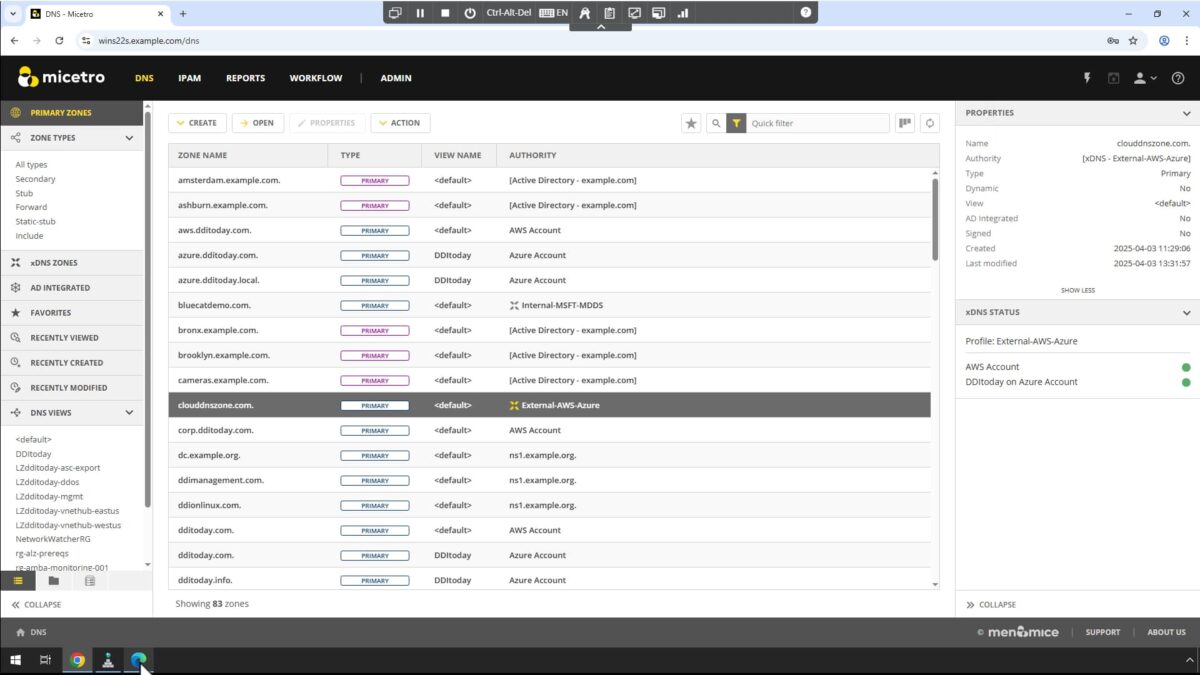Unlock DNS redundancy with BlueCat Micetro’s xDNS
Discover how Micetro’s xDNS simplifies hybrid cloud DNS management with redundancy, protection against DNS attacks, and enhanced visibility.

In today’s complex IT landscape, managing DNS across hybrid cloud environments can be challenging. Networks spanning on-premises infrastructure, Microsoft Azure, AWS, and beyond face numerous threats and potential points of failure.
To overcome these challenges, enterprises require robust, intelligent DNS solutions capable of ensuring resilience, optimizing performance, and enhancing security.
BlueCat Micetro’s xDNS feature is designed to deliver redundancy, mitigate DNS-based attacks, and simplify management in heterogeneous DNS environments and across multiple clouds.
In this post, we’ll explore why traditional DNS management tools fall short in hybrid environments. Then, we’ll look in depth at how Micetro’s xDNS brings added capability by unifying management of on-premise and cloud DNS. Finally, we’ll discuss why you should choose Micetro xDNS and provide a demo of it in action.
Traditional DNS tools fall short
Managing DNS with traditional tools or individual cloud-provider consoles introduces several critical issues:
- Single points of failure: Traditional DNS setups can become single points of failure, risking costly downtime if one server or service provider goes offline.
- Limited attack mitigation: Without redundancy, DNS servers become vulnerable to attacks such as Distributed Denial of Service (DDoS), leading to severe disruptions.
- Lack of hybrid visibility: Enterprises struggle with fragmented DNS management across multiple platforms, lacking cohesive visibility and control.

How xDNS changes the game
In previous posts, we looked at how easy Micetro makes managing on-premises Microsoft DNS and DHCP servers, as well as managing cloud-based DNS and IP spaces in Azure and AWS.
Micetro’s xDNS takes managing on-premises and cloud-based DNS, DHCP, and IP address management (together known as DDI) from simple management and orchestration to transforming enterprise DDI by offering powerful, intuitive controls to overcome traditional DNS shortfalls.
By unifying management of on-premises and cloud DNS, Micetro’s xDNS enhances IT capabilities, ensuring DNS availability and managing hybrid cloud environments in several ways:
Built-in redundancy and failover
With xDNS, administrators can effortlessly configure DNS redundancy groups across multiple service providers. This includes BIND, Windows DNS, Azure DNS, Amazon Route 53, NS1, Dyn, and Akamai Fast DNS.
Once an xDNS zone redundancy group has been created, xDNS creates identically replicated zone content, resulting in multiple identical primary zones. Additional DNS zones can be added or removed from the xDNS group as required.
Enhanced protection against DNS failure and attacks
Micetro’s xDNS maintains DNS zone records across multiple service providers or DNS servers. xDNS ensures that each server within the xDNS profile maintains appropriately unique NS and SOA records for the zone, while keeping other record types (A, CNAME, MX, etc.) in sync across providers.
In the event of an outage or attack, an alternate service provider will continue to authoritatively serve DNS requests.
Centralized visibility and policy-based synchronization
Micetro’s unified platform delivers complete visibility into DNS configurations and records across hybrid cloud environments. Administrators have the flexibility to define granular synchronization policies, determining exactly how DNS updates propagate between on-premises and cloud environments. This further reduces complexity and ensures consistency.

Robust automation and efficiency
Micetro’s comprehensive API support—including REST, SOAP, and JSON-RPC—empowers organizations to automate and customize DNS management workflows. By automating repetitive DNS management tasks, organizations reduce manual overhead, prevent human errors, and significantly enhance operational efficiency.
Record adds or changes done through the API are automatically replicated to all members of the xDNS redundancy group.
Why choose Micetro’s xDNS?
There are several reasons to choose Micetro’s xDNS:
- Reduce downtime and risk: Multiple primary zones across service providers provides automatic failover and proactive attack mitigation to ensure constant DNS reliability and security.
- Simplify hybrid DNS management: A centralized interface and powerful automation simplify management, reduce complexity, and enable scalability.
- Cost efficiency: Prevent costly DNS outages, as research shows outages can cost businesses several times more than maintaining a redundant DNS service.
Experience xDNS in action
Ready to see xDNS in action? Here’s a quick demo showcasing how Micetro xDNS provides robust DNS redundancy, whether on-premises, in hybrid cloud scenarios, or across multiple cloud providers.
Don’t settle for fragmented DNS management solutions. BlueCat Micetro’s xDNS empowers your network teams to build secure, reliable, and redundant internal and external DNS zones.
Ready to simplify and secure your DNS management? Request a free Micetro trial today to see Micetro’s powerful capabilities for yourself.





